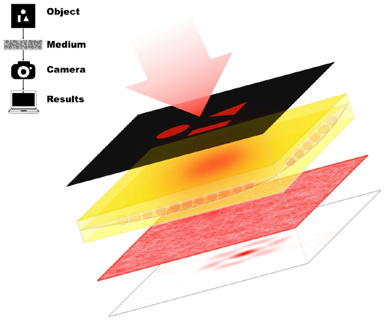 [Enlarge image]An object hidden behind an opaque layer is illuminated by a spatially incoherent narrowband light source. The object light passes through the scattering medium to the camera sensor, forming a random speckle pattern. Performing the cross- correlation product of the measured speckle patterns taken at different times makes it possible to track moving objects.
[Enlarge image]An object hidden behind an opaque layer is illuminated by a spatially incoherent narrowband light source. The object light passes through the scattering medium to the camera sensor, forming a random speckle pattern. Performing the cross- correlation product of the measured speckle patterns taken at different times makes it possible to track moving objects.
Imaging through scattering media has been a long-standing challenge in various fields, hindering progress in biomedical imaging, astronomy and aeronautics.1 Conventional optical imaging systems encounter difficulties when attempting to visualize objects that are concealed behind scattering layers and illuminated by a narrowband light source, forming a seemingly random speckle pattern.2 However, these speckle patterns are not entirely random—they exhibit determinism and high correlation with other speckle patterns generated from different illumination angles. By exploiting these correlations, we can extract detailed information about the hidden object through the scattering media.3
Previous research has demonstrated successful reconstruction of images of objects concealed behind opaque scattering layers using phase-retrieval algorithms.4 However, such methods become computationally expensive when dealing with moving objects. To address this issue, we recently proposed a new approach to tracking moving objects through scattering media. By performing a linear combination of the measured speckle patterns generated by the object at different times, our method accurately tracks the object’s relative motion without reconstructing the object image. This significantly reduces computational complexity, enabling real-time operation and offering a practical and efficient solution for image-retrieval problems. Additionally, our approach can track changes in the hidden object’s size, rotation or deformation, making it even more versatile and applicable.5
By presenting this correlation-based imaging approach, we provide a valuable tool for overcoming the limitations of conventional imaging systems in complex media. The ability to track moving objects through scattering media has promising applications in various fields, including biomedicine, astronomy and aeronautics, and we believe it could open new avenues for further research and advances in these areas.
Researchers
Yessenia Jauregui-Sánchez, Queen’s University Belfast, Belfast, Northern Ireland
Harry Penketh and Jacopo Bertolotti, University of Exeter, Exeter, UK
References
1. G. Sylvain et al. J. Phys. Photon. 4, 042501 (2022).
2. J.W. Goodman, J. Opt. Soc. Am. 66, 1145 (1976).
3. J. Bertolotti et al., Nature 491, 232 (2012).
4. V. Elser, J. Opt. Soc. Am. A 20, 40 (2003).
5. Y. Jauregui-Sánchez et al. Nat. Commun. 13, 5779 (2022).
